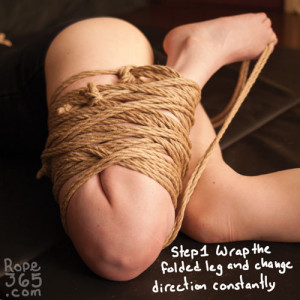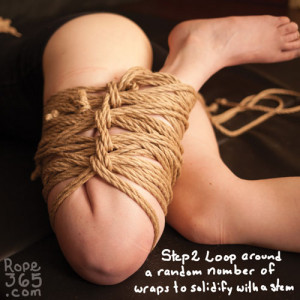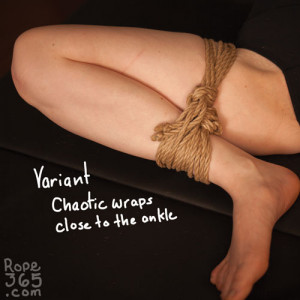Day 26: Chaos
The essence of the frog tie is to hold the leg in a folded position, but it doesn’t always have to be a specific pattern. You can achieve a different aesthetic with something that is less constructed and the sensation will be much different.
Chaotic Frog tie
Time to get chaotic a little bit and improvise a tie. Instead of making clean wraps from ankle to knee, change direction so that the rope crosses on itself. Make as many wraps as you want!.
Once you feel ready to move on, you can solidify everything with frictions, creating a stem. You can catch a single rope or a bunch of them at the same time. The same principle can be applied on both sides for more solidity.
Practice Time!
Design your own chaotic frog tie and play with the sensation of the tie.
Self-evaluation checklist:
- Are there any painful sensations? In particular from overextension at the knee or on the front of the tibia bone.
- Is the leg fully bent, can the leg still move at the knee?
- Frictions are tight and compact with no undesired twists
- Tension is even across the tie (some uneven tension is expected)
- Move the leg around, does the tie stay in place?
- Pull the stem in different directions; how does it hold?
- How is the blood circulation? Does the foot become numb after some time?
Exploration ideas:
- Which part of the leg do you want to cover with rope? From ankle to knee? Stay close to one end? Create a gap?
- Try a more minimalist approach.
- Play with gaps and pinches on purpose.
- How many ropes can be added until you can’t see the thighs and calf anymore?
Being Tied: Dealing with Repetition – sansblague
To be in a folded leg position for five days in close succession – which you will be if you are doing the 365 rope days together with someone – comes with certain challenges. Here are some tips for being kind to yourself in any situation of monotonous rope repetition:
- Start by doing a bit of warm-up, especially of the joints involved in the practice. In this case, you could do a bit of jogging on the spot, varying the run by getting your knees up high or trying to kick your buttocks with your heels. Or, if you want to start off softer, you can lie on your back and fold and stretch your knees until they feel soft and ready for action.
- Just because the pattern is roughly the same does not mean that the body position has to be the same. In the case of futomomos, you can vary between sitting, lying on your side, lying on your belly, lying on your back and even standing (watch your balance, though!).
- If you usually love rope, don’t get disappointed with yourself or your partner if some days you find it boring. Your rope travel will have its ups and downs, and it is ok to not be ecstatic all the time. If, however, you feel that you are hurting yourself mentally or physically by sustaining the practice, stop and find another way to go about it.
- When you get out of the rope, take a moment to let the body readjust. Do some small physical activity that feels comfortable and good in that moment. Maybe in this case you could for example start by gently unfolding your knee and checking in with the joint before getting up slowly and pacing around a bit.
Inspirations and Resources
- Patello-Femoral Syndrome (Chondromalacia) from Floorwork Futomomo by _Estella
Chaotic futomomo vs location where things cross vs nerve and circulation
Credit: Idea inspired by Zamil – M: Faustine R/P: Ebi McKnotty
Or return to Frog Ties for more options.




Leave a Reply